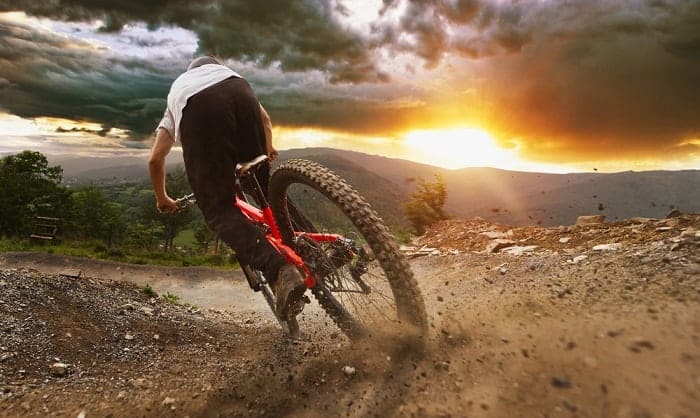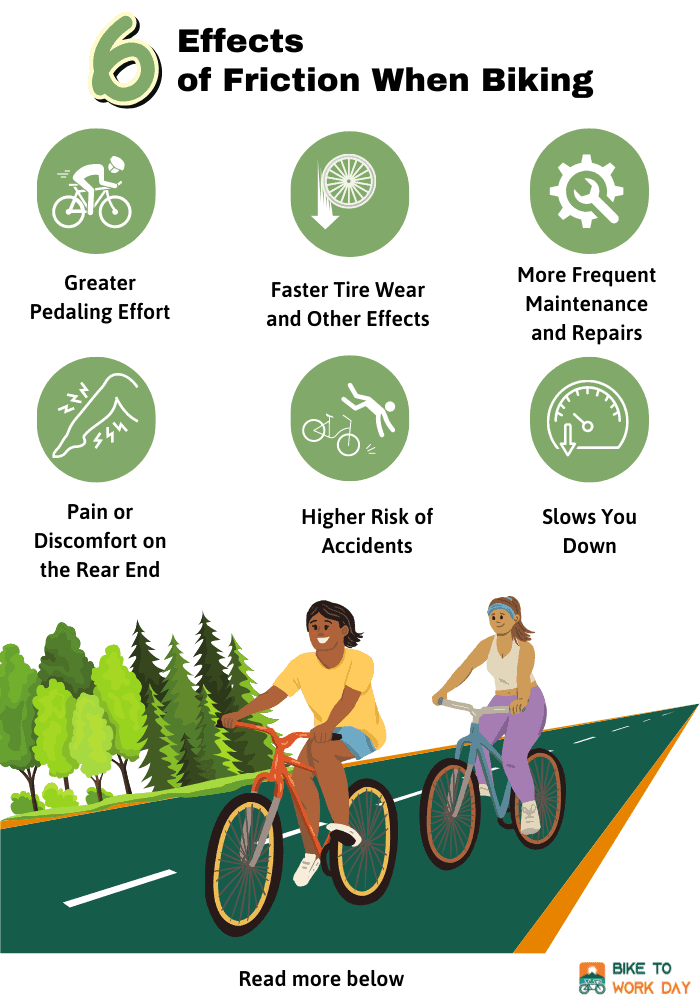Have you ever wondered if friction is a friend or foe whenever you take your bike for a stroll? We have heard experienced bikers say friction helps you stay safe, especially when navigating a hairpin in a blitz. It begs the question, how is friction harmful when riding a bike? As a matter of fact, friction may cause pain, discomfort and a higher chance of accidents when we are on the road.
Join me in exploring the friction bicycle conundrum, determining, once and for all, whether this unseen natural force is something we should worry about whenever we hit the road or not.
Table of Contents
What is Friction
I find it valuable to have a common understanding of what friction means before I name 1 way that friction is harmful when riding a bicycle.
Friction is an invisible force created by the rubbing or collision of two surfaces.
Try rubbing your hands together, and you will sense a form of resistance and, subsequently, heat.
In general, two objects moving in the opposite direction will create friction. This natural force also slows down the movement of either item.
When biking, friction occurs between the bicycle and the pavement. It also develops in any contact point between two bike surfaces and between the bicycle and your body.
For example, your butt will create friction when it rubs against the bike seat. The chain also produces friction as it contacts the sprockets.
What are the Effects of Friction When Biking
We now have a fair understanding of what friction is about. Let us now look at the ways friction can be harmful when riding a bike.
Greater Pedaling Effort
The most obvious answer to the friction bike enigma is more substantial pedaling effort.
Have you ever wondered why Formula 1 race-cars only use slick tires and not the ordinary road tires we have in our cars? Slick racing tires minimize the friction they have on the road, allowing them to go faster.
Race-cars are also aerodynamically designed, allowing the air to move smoothly around the chassis and improving speed.
We can take these racecar characteristics and apply them to your biking adventures.
First, your bicycle tires have treads that allow firm contact with the road to prevent fall-related accidents. Unfortunately, tire channels create friction with the road, making it more difficult to pedal. The only way you can speed up is to pedal faster.
Second, there is the terrain to worry you. Most roads that bikers use are not suitable for racing. For example, dirt and mountain bikers make uneven terrain their favorite adventure grounds. Sadly, rocky, sandy, and harsh environs can create friction and make you want to pedal more forcefully.
Third, air resistance can also create friction with the body. A strong gust of wind can undermine your pedaling efforts and reduce bike speed. Your natural reaction will be to pedal with more significant exertion.
Fourth, road gradients can also play against you. Biking uphill will be slower than going downhill, requiring more pedaling effort on your part. The incline also creates friction because it slows your biking progress. You also have gravity pulling you and hampering your efforts.
Faster Tire Wear and Other Effects
Friction increases wear on the object with a softer composition. You can expect your bicycle tires to wear thin faster with constant friction. While paved roads also wear over time, concrete has a more solid structure than tire rubber.
Using the correct tires is essential. For example, when going on a mountain biking adventure, you will need knobby tires that ensure a firm grip on off-road environments. Try taking your road bike to the mountains, and you are courting fall-related accidents.
Likewise, you cannot use knobby tires on city streets because there is less contact surface (less friction) between the road and the bike tires. What you need are regular tires with enough treads to grip the pavement.
Underinflating your tires can also increase friction with the road, making it risky to bike.
More Frequent Maintenance and Repairs
How is friction harmful when biking? How about more frequent maintenance and repairs?
The more substantial the friction generated by the biking adventure, the faster the frictional components will wear. It can also damage some parts beyond repair, requiring a costly replacement.
That is why seasoned bikers invest in a good-quality lubricant for bicycles to reduce friction on moving metal parts, such as wheel bearings, chain wheels, and cog bearings.
You might want to try the Finish Line Dry Bike Lubricant because you can spray it on frictional components without remaining wet and tacky. The product dries quickly, protecting the bicycle parts from dust, grit, and grime. Doing so reduces maintenance requirements.
Lubricating your bike also reduces pedaling effort, allowing you to ride your bike at a more pleasant speed.
Pain or Discomfort on the Rear End
You might think substantial pedaling will strengthen your leg muscles. While it does, you forget something else – your rear end or butt.
Pedaling requires you to shift your weight from side to side, allowing you to generate more force on the downward pedal stroke. Unfortunately, this action also creates friction between your rear end and the bicycle seat.
You might also feel the warmth between your groins where they contact the bike seat’s leading edge.
The constant rubbing can irritate the skin, leading to inflammation and discomfort. If you do not take care of it at once, the inflammation can progress to sores, a more painful skin condition that can rob you of the pleasures of biking.
Higher Risk of Accidents
Friction can also cause accidents.
Bumpy, rocky, sandy, and uneven terrain not only produce friction. Strong winds can also lead to accidents, especially when you lose your balance and fall off your bike.
You might shrug off a few bruises, but fractures and deep open wounds are a different matter. These biking-related injuries require more than a simple application of an antibiotic ointment. The treatment can be costly, and the recovery is sufficiently long, you will not be able to ride your bicycle.
Friction can also hurt the joints. Gentle pedaling may not lead to osteoarthritis or some other health problem. However, more forceful exertion can irritate the joint capsule and produce inflammation. Before you know it, you already have knee arthritis.
Slows You Down
This is not an issue if you are on a leisurely ride. However, if you are competing against your friends for the unofficial title of speed biking king, friction can work against you.
Remember what we said about friction being a natural slowing force? When you bike against the wind, strong gusts of air will push you from the opposite direction. You will find moving forward challenging unless you exert more force in pedaling.
Underinflated tires also increase friction, reducing your speed and robbing you of the title. Uneven terrain can also slow you down because you must focus on maintaining balance instead of speed.
Conclusion
How is friction harmful when riding a bike? This natural force can make you pedal more forcefully, take you off your rhythm, and upset your balance. It can lead to accidents or discomfort while also increasing the frequency of bike maintenance and repairs.
That is why it is always a good idea to look at your bicycle tires, correct cycling position, and overall situational awareness to make friction your friend – not foe – when you go on a biking adventure.

“Bike commuting should be the trend for the next few years, and it is a convenient and eco-friendly way for us to travel. And we are here to make it a bit less troublesome for people who want to maintain their vehicle for a long time. So, the content I expect to put out here is offering help for bikers who are facing issues with parts of their bikes once in a while. Let’s have fun and protect the environment together!”




